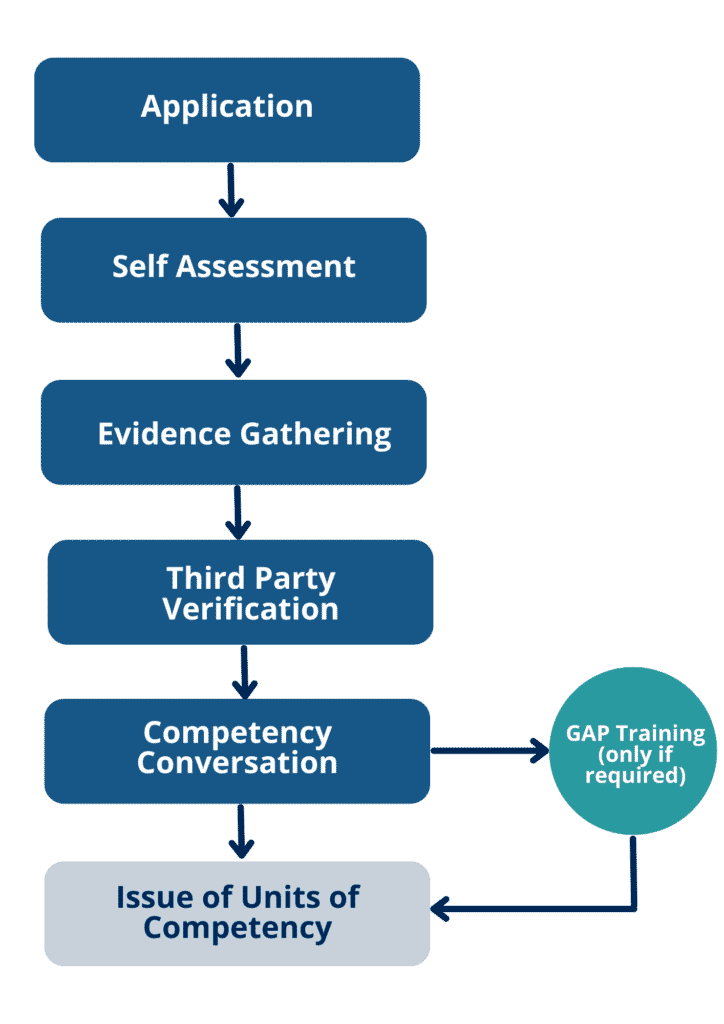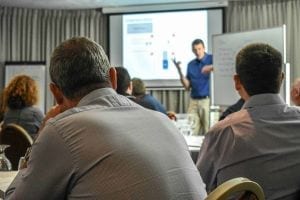Recognition of Prior Learning (RPL) & Credit Transfer
Recognising your knowledge and skills
Steps in the RPL Process

Find out more:
Recognition of Prior Learning (RPL) is an assessment process of your past experience and background against units of competency. It is a method of achieving nationally-recognised qualifications under the Australian Qualification Framework (AQF). As an RTO, we evaluate and assess your work and life experience, knowledge and skills against pre-determined criteria. These can be obtained through life experiences, career and activities (such as volunteering) or other units of competency.
RPL is all about evidence. While we would love to take your word on all your lifetime knowledge and experiences, unfortunately, we cannot. To award RPL we require solid evidence which maps directly to the unit of competency and its requirements. Providing your CV, work history or certificates of previous training/education alone, is not sufficient for RPL. You will also need to provide extensive supporting evidence.
The AQF provides a formal explanation on what is an RPL, here.
If you have completed past studies in areas related to the qualification you plan to enrol in, and have achieved the required units, you may be eligible for credit transfer.
Credit transfer is a process that provides students with agreed and consistent credit outcomes for components of a qualification. It is based on identified equivalence in content and learning outcomes between matched qualifications.
Credit Transfer relates to the recognition of equivalent units issued by RTOs other than Southpac Aerospace or the recognition of superseded units issued by other RTO’s or Southpac Aerospace. You will need to provide certified documentation of your past study so an assessor can make a decision about whether a credit transfer can be granted.
Step 1- Application
Contact the office to determine if RPL is a suitable option.
Step 2 – Self-assessment
You will be given an RPL Assessment Kit and self-assessment to complete. Provide information of your skills and experience and provide as much information of your previous experience as you can.
Step 3 – Evidence Gathering
You are required to complete a checklist and gather your evidence for submission. This is your first opportunity (and not the last) to provide proof of your variety of experience in the industry.
Step 4 – Third Party Verification
You will need to supply contact details of one or two work referees who can confirm your skills in the industry.
Your work referees will need to sign off that they have observed your work.
Step 5 – Competency Conversation
At this part of the RPL process you will have a competency conversation interview with an assessor. The assessor will review the information you have provided and begin to match up your skills to the units of competency you are requesting RPL for.
The assessor will also ensure that the information you have provided is Authentic, Current and Sufficient.
At this point, you will have the opportunity to discuss and identify your previous experience with the assessor who will understand your industry experience and conduct a competency conversation with you. You will be required to answer industry related questions to identify your current skills.
Further Steps
After the assessment, your assessor will give you information about the skills that have been recognised and whether you have met the requirements of RPL. If you do have skill gaps, these may be addressed through flexible training.
It is a general requirement that you are able to supply examples of your work history and provide proof to back up the claims made within the RPL Assessment Kit document. The documentation to include with your RPL submission fall into three categories and include into Mandatory, General and Competency Specific documentation.
Documents that you may include in your RPL submission include (are not limited to):
- Any licences
- Detailed CV or Work History
- Certificates/Results of any prior Training/Assessment relevant to this Qualification
- Indentures/Trade Papers
- Certificates/Results of Assessment – universities
- Results/Statement of Attendance/ Certificates – vendor training courses
- Results/Statement of Attendance/ Certificates – in house courses
- Results/Statement of Attendance/ Certificates – workshops, seminars, symposiums, etc.
- Results/Statements of Attendance/ Certificates – club courses e.g. first aid, officials etc.
- Photographs of work undertaken e.g. during shift work and to be verified by an Employer Representative in charge of the respective work.
- Diaries/task sheets/job sheets/logbooks
- Inhouse training records
- Any induction records relevant to Automotive industry
- Membership of relevant professional associations
- Hobbies/interests/special skills outside work
- References/letters from previous employers/supervisors
- Industry awards
- Any other documentation that may demonstrate industry experience
Each RPL kit will also provide further details on specific documentation that may be required on a unit by unit basis.
RPL Kits Under Construction
Our RPL assessment kits are currently being updated following the changes to the Business Services Training Package by ASQA.
To achieve a qualification, it is important to have an understanding of the units of competency you need to obtain. This assists in identifying your skills and knowledge to be deemed competent. Our RPL kits are designed for all units of competency that can be used towards a qualification issued by Southpac Aerospace. These kits will help determine if RPL the right option for you.
RPL $250 per unit
Credit transfer $100 per unit
1.How can I obtain recognition of prior learning or RPL?
By applying with us, using our RPL assessment process, which is detailed in the sidebar on this page.
According to ASQA, all accredited training organisation are required to offer RPL when a student is accepted, so if you are thinking of studying with us, contact us about how to apply for your RPL.
2.Why do you need to get an RPL?
- to comply with regulations or licensing within an industry
- to formally recognise skills gained through other various activities
- to upgrade skills for job promotion
- to give similar standing of skills to achieve qualification to train/audit others
- to convert qualifications from overseas to comply with Australian standards
3.What is the difference between RPL and credit transfer?
Recognition of Prior Learning (RPL) refers to having sufficient evidence of experience, skills or knowledge through other means but haven’t specifically studied the unit.
Credit transfer refers to the completion of a unit through a course. You must provide a statement of attainment or transcript that shows the unit as complete. Units studied more than a couple of years may have been superseded and may require further evidence of qualification.
4.Is getting RPL a long and difficult process?
No and yes. At Southpac, we make sure the process is as streamlined as possible. By completing the relevant documents and supplying us with the necessary items, you could be well on the way to obtaining your RPL. However, gathering and presenting the evidence can take just as long as studying and completing the course itself. Please take these factors in consideration when determining if RPL is right for you.
5.How much experience do you need to gain RPL?
Generally, you need substantial evidence of experience to qualify for the Diploma level of qualification. Time in a work position, type of experience and other determining factors help to evaluate your eligibility for RPL.
6.What are the types of evidence that we use as evidence for RPL?
Almost any formal, non-formal and informal activities related to the unit of competency you are requesting RPL for, can be used as evidence. These could include but not limited to:
- verbal communication with assessor
- position descriptions
- work experience evidence
- references
- compliance records
- qualification, transcripts
- task lists
- PowerPoint presentations
- work activities – meeting notes, project plans, correspondences
- performance reviews or staff appraisals
- incident reports
- other activities determined as evidenced by your assessor to prove competence
7.How does the assessor review the evidence gathered?
The assessor evaluates your evidence against the units of competency using the ASQA rules of evidence (Table 1.8-2). This includes:
- Current – the evidence must be completed in recent years. For example in the last couple of years.
- Authentic – the evidence must be validated as your own.
- Valid – that you have enough evidence that you have the skills, knowledge and attributes against the unit of competency.
- Sufficient – there must be enough evidence in quantity and quality and be relevant.
8.Is there a cut-off timeframe for RPL evidence to be considered valid?
Yes, our assessors use the ASQA rules of evidence to determine the authenticity of your evidence which works within a five-year cut-off period. To ensure that your qualification is current and credible to regulators and employers, evidence of current experience (less than five years old) is important. This retains the integrity of the qualification as being to the highest standard required to obtain the unit of competency and proves you are up to date on industry practices and regulations.
9.Are RPL units recognised as a similar qualification to other forms of training?
No matter how you achieved your qualification, units of competency are treated in similar standing by the National Skills Framework.
10.I have started my RPL and realise my evidence is not applicable. What do I do?
Not a worry, we aim to assist our participants as much as possible in obtaining RPL. Please contact your assessor as soon as possible to discuss alternative solutions in supplying the correct evidence.
11.Do I need to pay upfront?
Payment is due before issuing of certificates.
12.How much do RPL units costs?
We ask for a small investment fee of $250 per unit for our assessors to evaluate your information.
As an RTO, we are responsible under the Standards for Registered Training Organisations (RTOs) 2015 to ensure the authenticity of our student’s assessment work and these will be done in the following ways in relation to Credit transfer and RPL.
Credit Transfer – third-party verification:
Upon application for credit transfer with Southpac, you will be required to provide permission to verify with the issuing RTO the authenticity of all certificates or statements of attainment that you provide to us as evidence.
RPL – submission of certificates:
Any copies of certificates that wish to be used towards RPL must be certified by a Justice of the Peace or a Commissioner for Declarations.
Contact us to enquire about RPL or Credit Transfer.
Ph: +61 (07) 5533 9988
Email: [email protected]






